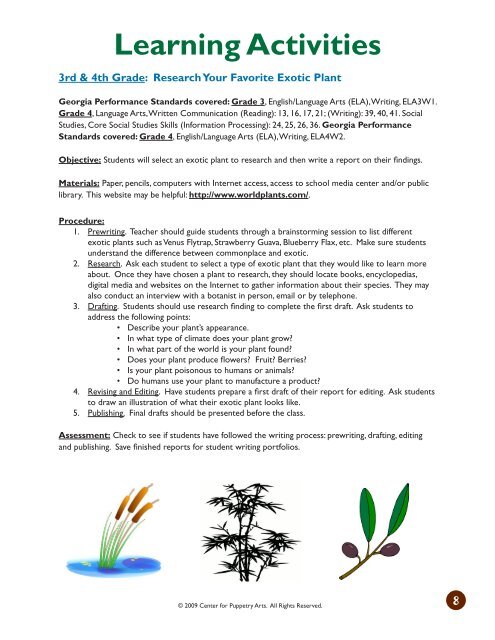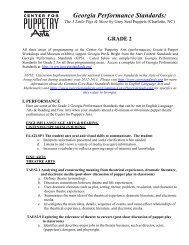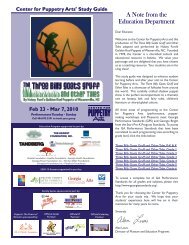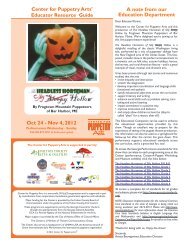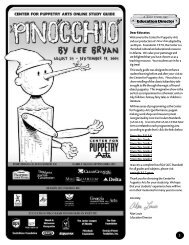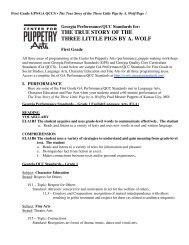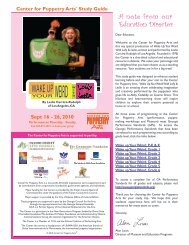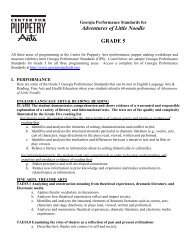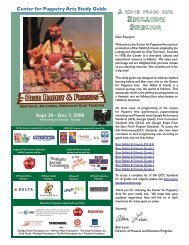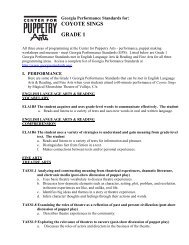Jack & the Beanstalk - Center for Puppetry Arts
Jack & the Beanstalk - Center for Puppetry Arts
Jack & the Beanstalk - Center for Puppetry Arts
You also want an ePaper? Increase the reach of your titles
YUMPU automatically turns print PDFs into web optimized ePapers that Google loves.
Learning Activities<br />
3rd & 4th Grade: Research Your Favorite Exotic Plant<br />
Georgia Per<strong>for</strong>mance Standards covered: Grade 3, English/Language <strong>Arts</strong> (ELA), Writing, ELA3W1.<br />
Grade 4, Language <strong>Arts</strong>, Written Communication (Reading): 13, 16, 17, 21; (Writing): 39, 40, 41. Social<br />
Studies, Core Social Studies Skills (In<strong>for</strong>mation Processing): 24, 25, 26, 36. Georgia Per<strong>for</strong>mance<br />
Standards covered: Grade 4, English/Language <strong>Arts</strong> (ELA), Writing, ELA4W2.<br />
Objective: Students will select an exotic plant to research and <strong>the</strong>n write a report on <strong>the</strong>ir findings.<br />
Materials: Paper, pencils, computers with Internet access, access to school media center and/or public<br />
library. This website may be helpful: http://www.worldplants.com/.<br />
Procedure:<br />
1. Prewriting. Teacher should guide students through a brainstorming session to list different<br />
exotic plants such as Venus Flytrap, Strawberry Guava, Blueberry Flax, etc. Make sure students<br />
understand <strong>the</strong> difference between commonplace and exotic.<br />
2. Research. Ask each student to select a type of exotic plant that <strong>the</strong>y would like to learn more<br />
about. Once <strong>the</strong>y have chosen a plant to research, <strong>the</strong>y should locate books, encyclopedias,<br />
digital media and websites on <strong>the</strong> Internet to ga<strong>the</strong>r in<strong>for</strong>mation about <strong>the</strong>ir species. They may<br />
also conduct an interview with a botanist in person, email or by telephone.<br />
3. Drafting. Students should use research finding to complete <strong>the</strong> first draft. Ask students to<br />
address <strong>the</strong> following points:<br />
• Describe your plant’s appearance.<br />
• In what type of climate does your plant grow?<br />
• In what part of <strong>the</strong> world is your plant found?<br />
• Does your plant produce flowers? Fruit? Berries?<br />
• Is your plant poisonous to humans or animals?<br />
• Do humans use your plant to manufacture a product?<br />
4. Revising and Editing. Have students prepare a first draft of <strong>the</strong>ir report <strong>for</strong> editing. Ask students<br />
to draw an illustration of what <strong>the</strong>ir exotic plant looks like.<br />
5. Publishing. Final drafts should be presented be<strong>for</strong>e <strong>the</strong> class.<br />
Assessment: Check to see if students have followed <strong>the</strong> writing process: prewriting, drafting, editing<br />
and publishing. Save finished reports <strong>for</strong> student writing portfolios.<br />
© 2009 <strong>Center</strong> <strong>for</strong> <strong>Puppetry</strong> <strong>Arts</strong>. All Rights Reserved.<br />
8


